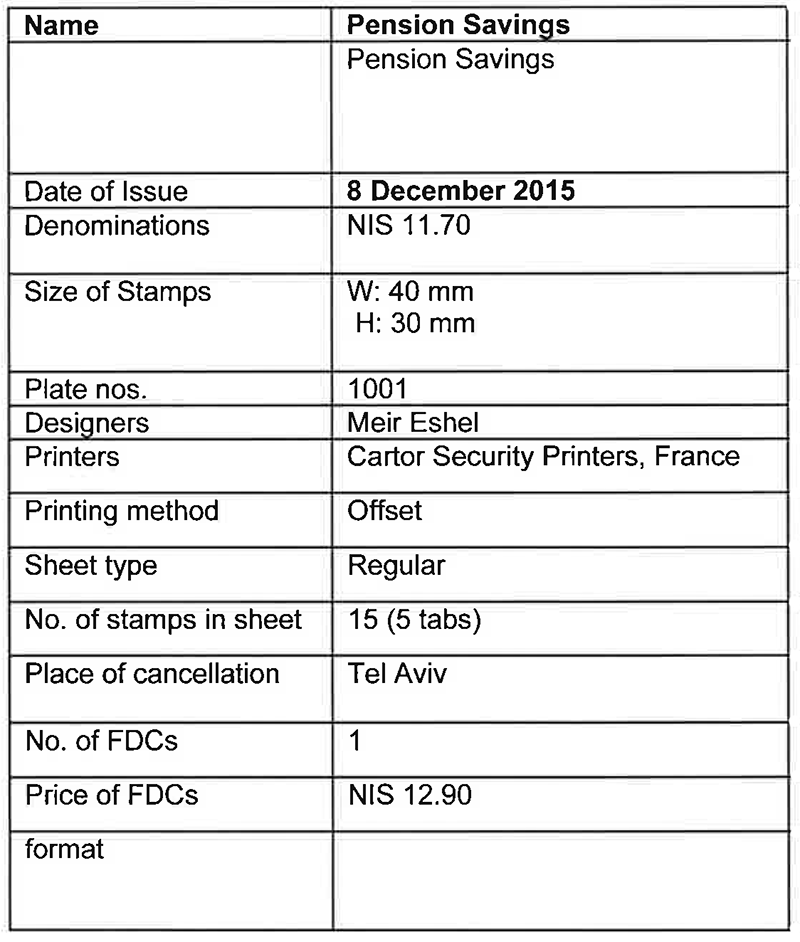“The last but not least in our Partridges and Allies ATM series is the cute Quail, the smallest of this species,” says Israel Post. This label is being issued in December. 
Monthly Archives: November 2015
Season’s Greetings (Israel 2015)
Christmas (Canada, 2015)
[press release
 OTTAWA – Canada Post combines whimsical holiday Canadiana with a traditional sacred Christmas image in this year’s holiday stamps offering. These beautifully designed stamps will add a special touch of holiday joy to cards and letters sent across the country and beyond.
OTTAWA – Canada Post combines whimsical holiday Canadiana with a traditional sacred Christmas image in this year’s holiday stamps offering. These beautifully designed stamps will add a special touch of holiday joy to cards and letters sent across the country and beyond.
 Charming close-ups of a moose, a beaver and a polar bear are each decked out in retro festive attire on these bold and amusing PermanentTM domestic, U.S.- and International-rate stamps. Elements of clothing flowing beyond the edges of the stamp frame emphasize the stylish humour of these Canadiana cameos.
Charming close-ups of a moose, a beaver and a polar bear are each decked out in retro festive attire on these bold and amusing PermanentTM domestic, U.S.- and International-rate stamps. Elements of clothing flowing beyond the edges of the stamp frame emphasize the stylish humour of these Canadiana cameos.
The fourth stamp, a Permanent domestic stamp, features an image from a nativity-themed painting by Adraen Isenbrandt entitled The Adoration of the Magi. The painting, from the early 16th century, 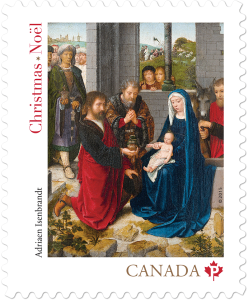 depicts the moment when Mary, Joseph and the baby Jesus behold the arrival of the Magi. The Wise Men can be seen in the background. The painting was photographed for the stamp by Denis Farley, and the image was made available courtesy of the Montreal Museum of Fine Arts. The painting was part of a generous donation made to the museum by Michal and Renata Hornstein.
depicts the moment when Mary, Joseph and the baby Jesus behold the arrival of the Magi. The Wise Men can be seen in the background. The painting was photographed for the stamp by Denis Farley, and the image was made available courtesy of the Montreal Museum of Fine Arts. The painting was part of a generous donation made to the museum by Michal and Renata Hornstein.
“The world’s first Christmas stamp was issued in Canada in 1898, and at Canada Post we value that tradition,” says Deepak Chopra, President and CEO of Canada Post. “The holiday stamps are the final issue in this year’s stamp program, and they are ever-popular.”
About the Christmas stamps:
 Christmas – Animals: Designed by Paprika and illustrated by well-known painter, illustrator and artist Gérard DuBois, each of the 3 stamps measures 22 mm by 24 mm. The stamps are printed by Lowe-Martin in 5 colour lithography. The Permanent™ domestic stamps are available in booklets of 12 and the U.S. rate and International rate stamps are each available in booklets of 6. Souvenir sheets of all 3 stamps are available. The Official First Day Cover cancellation site is Christmas Island, N.S.
Christmas – Animals: Designed by Paprika and illustrated by well-known painter, illustrator and artist Gérard DuBois, each of the 3 stamps measures 22 mm by 24 mm. The stamps are printed by Lowe-Martin in 5 colour lithography. The Permanent™ domestic stamps are available in booklets of 12 and the U.S. rate and International rate stamps are each available in booklets of 6. Souvenir sheets of all 3 stamps are available. The Official First Day Cover cancellation site is Christmas Island, N.S.
Christmas – Madonna and Child:  Designed by Louise Méthé, this Permanent™ domestic stamp measures 26.25 mm by 32.25 mm. The stamp was printed by Canadian Bank Note in 6 colour lithography. It is available in booklets of 12. The Official First Day Cover cancellation site is Montréal, Que.
Designed by Louise Méthé, this Permanent™ domestic stamp measures 26.25 mm by 32.25 mm. The stamp was printed by Canadian Bank Note in 6 colour lithography. It is available in booklets of 12. The Official First Day Cover cancellation site is Montréal, Que.
To purchase these stamps and other philatelic products, please visit canadapost.ca/shop
Britain’s 2016 Special Stamp Program
7 Jan: Shackleton and the Endurance Expedition
17 Feb: Royal Mail 500
15 Mar: British Humanitarians
5 Apr: Shakespeare
21 Apr: HM The Queen’s 90th Birthday
17 May: Animail
21 June: First World War – 1916
7 July: Music Giants
28 July: Beatrix Potter
16 Aug: Landscape Gardens
2 Sept: The Great Fire of London
15 Sept: Agatha Christie
20 Oct: To be announced
8 Nov: Christmas
More details will be released the last week of 2015.
Theater and Entertainment Personalities (Israel 2015)
Theater and Entertainment Personalities – Channa Marron, Sefi Rivlin
December 2015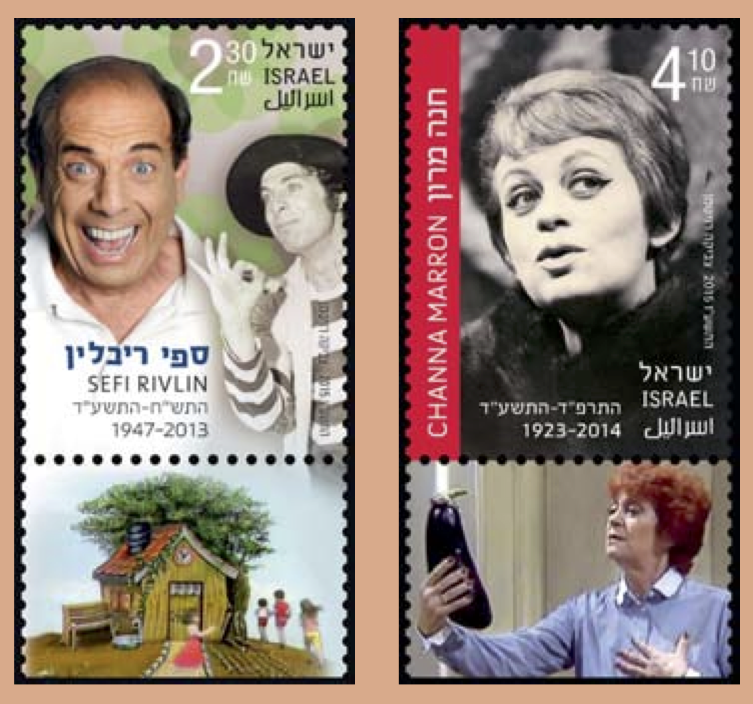
Channa Marron and Sefi Rivlin were two of the most prominent and iconic artists of the Israeli stage. Channa Marron, who was born in Berlin, was known mainly for classic theater while Sefi Rivlin, a native-born Israeli, was renowned for his comedic abilities. Each of these artists earned a place in the pantheon of Israeli culture.
Channa Marron 1923 – 2014
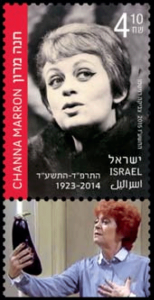 Channa Marron, née Mayerzak, known as the first lady of Israeli theater, began her acting career at the age of four in her native Berlin. Hanne’le Mayerzak starred in over twenty plays (including the first theater production of Pünktchen und Anton by Erich Kästner), seven films (including M – the first sound film by Fritz Lang) and numerous radio plays. In 1933 she had to leave Germany. After two years in Paris, where she portrayed leading roles in a number of plays, Mayerzak-Marron finally settled in Tel-Aviv and was soon integrated into the local Hebrew-speaking theater.
Channa Marron, née Mayerzak, known as the first lady of Israeli theater, began her acting career at the age of four in her native Berlin. Hanne’le Mayerzak starred in over twenty plays (including the first theater production of Pünktchen und Anton by Erich Kästner), seven films (including M – the first sound film by Fritz Lang) and numerous radio plays. In 1933 she had to leave Germany. After two years in Paris, where she portrayed leading roles in a number of plays, Mayerzak-Marron finally settled in Tel-Aviv and was soon integrated into the local Hebrew-speaking theater.
Channa Marron studied at Habima acting studio until, in 1941, she left to join the British Army. Following two years of service in Cairo, she was recruited by ENSA into the Jewish Brigade’s entertainment troupe, in which she played a key and memorable role.
After WWII Ms. Marron joined the founders of the Cameri Theater and took part in the formation of the theater’s distinctive character. Marron performed in dozens of Cameri productions, and is especially remembered for her portrayal of key roles in classic dramatic plays first translated or performed in Hebrew (including major works by Shakespeare, Schiller, Ibsen, Chekhov, Seneca, Wilde, Bernard Shaw, Eugene O’Neill, Tennessee Williams, Arthur Miller, Jean Anouilh, Beckett and Pinter) as well as classic plays by Israeli playwrights from Shamir, Alterman and Goldberg to Shulamit Lapid and finally Hanoch Levin.
In February 1970, while starring in a musical stage production of Hello Dolly, Marron was severely injured in a terrorist attack at Munich Airport. Her left leg was amputated in order to save her life. A mere one year later, Marron was back on the Cameri Theater stage as Medea in the play by Seneca. From the early 1980’s she began performing in other theaters, including Habima and Beer Sheva and also starred in the well known television series Krovim Krovim (Close Relatives). In addition to the many theater productions in which she took part, Marron also participated in seven Israeli films (directed by Avraham Hefner, Amos Gitai, Moshe Mizrahi), she was versed and involved in Hebrew poetry and devoted to its reading, and taught and directed at Beit Zvi School of Performing Arts and at Tel Aviv University. In 2000, Channa Marron was among the founders of the Herzliya Ensemble theater company, where she performed and also directed. Marron was active in political and civil organizations and initiatives promoting peace and coexistence in the region.
Channa Marron received many awards for her work in the theater and cinema, as well as her artistic endeavors, including the Israel Prize in 1973.
Thanks to Dr. Ofra Rechter, daughter of Channa Marron and Dor Wertheimer, Channa Marron Archive.
Sefi Rivlin 1947 – 2013
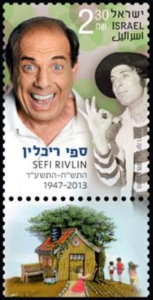 Yosef (Sefi) Rivlin was a versatile, respected and beloved actor and comedian, a virtuoso and one of Israel’s premier artists.
Yosef (Sefi) Rivlin was a versatile, respected and beloved actor and comedian, a virtuoso and one of Israel’s premier artists.
His diverse career spanned a wide range of roles in the theater, film, festivals, musicals, one-man shows, television series and more.
He was awarded the Israeli Television Academy Award and a Golden Mask Prize for lifetime achievement.
Sefi Rivlin studied acting at the Beit Zvi School for Performing Arts and belonged to the original Khan Theater troupe when it was founded in 1973. His first starring role was in Servant of Two Masters, for which he was nominated for a Kinor David Award.
He participated in many televisions series, first as a cast member on the satirical show Nikui Rosh and later Rega im Dodley, BaBayit shel Fistuk, HaTizmoret, Itche and more. Rivlin portrayed numerous film roles, including the leading role in HaShiga’on HaGadol.
Alongside his artistic success, Sefi volunteered for many years in his city of Rishon LeZion and was recognized by the city as an honored citizen. A social activist, he served on the city council and as a cultural advisor to the mayor. He worked to encourage reading, founded a club that conducted classes for adults and youths, volunteered with medical organizations and promoted the establishment of centers for art and the Hebrew language.
Sefi Rivlin was a bold comedic actor, exuding a charming and captivating kind of madness.
Gidi Marinsky, Israel Philatelic Service
Description of the Stamps and the First Day Covers:
Channa Marron
The stamp features a photographed portrait by Israel Haramaty and a photograph from the television series Krovim Krovim, courtesy of Israel Educational Television. The First Day Cover features a caricature by Zeev (Yaakov Farkash) from the Zeev Collection, the Israeli Cartoon Museum, Holon courtesy of his daughters Naomi Farkash- Fink and Dorit Farkash-Shuki.
Sefi Rivlin
The stamp features a photographed portrait by Raphael Ben Dor.
The stamp and tab feature photographs from the television series BaBayit shel Fistuk. The FDC bears an illustration by Zina Roitman of Sefi Rivlin based on a photograph of a scene from BaBayit shel Fistuk.
Pension Savings (Israel 2015)
December 2015
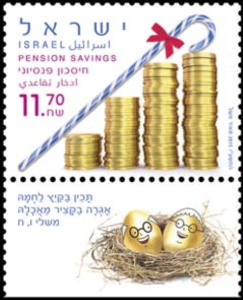 Pension Savings is a comprehensive term for the provident and pension funds that ensure sufficient income after retirement. Most pension funds include a savings component and an insurance component that protects the client and his family in case of death or injury. The State of Israel decided to encourage pension savings by offering a significant tax benefit to employees.
Pension Savings is a comprehensive term for the provident and pension funds that ensure sufficient income after retirement. Most pension funds include a savings component and an insurance component that protects the client and his family in case of death or injury. The State of Israel decided to encourage pension savings by offering a significant tax benefit to employees.
Overall pension savings have increased from NIS 180 billion in 2001 to some NIS 600 billion in 2014. Thirty percent of pension savings are invested in designated government bonds, linked to CPI plus 4.8% interest. This growth significantly increased the inflow of funds to the Israeli stock market and has turned pension savings into a significant player in the Israeli capital market.
In 2003, the retirement age was raised in order to decrease government expenses and increase future pension payments. Today, pension fund clients are able to move their pension savings from one fund to another with no limitations.
Pension contributions have been mandatory for all employers and employees since 2008 – a step that added 1 million employees to the population of savers. Mandatory pension applies to all employees from age 21 for men and age 20 for women to retirement age.
In 2015, The Department of Capital Market, Insurance and Savings at the Ministry of Finance announced a planned reform in the pension savings market, which will include steps to reduce centralization and to increase competition, in view of the fact that the pension sector is the fastest growing sector in Israel’s financial market.
Israeli Nostalgia (Israel 2015)
December 2015 During the past decade, a wave of nostalgia has swept through Israel and the world. This nostalgia stems from a sense that the progressive world in which we live, with its rapid technological advances and terms such as “global village” and “virtual world” creates feelings of alienation, as opposed to the intimacy remembered from earlier times.
During the past decade, a wave of nostalgia has swept through Israel and the world. This nostalgia stems from a sense that the progressive world in which we live, with its rapid technological advances and terms such as “global village” and “virtual world” creates feelings of alienation, as opposed to the intimacy remembered from earlier times.
Thus, we look back to a place where we felt content, comfortable and safe – to childhood, to the past, to the pleasant realm of nostalgia. The Tembel Hat, Soda Siphon and Sussita car featured in this stamp series are examples of things that remind us of days gone by and fill us with pleasant memories of the past.
Tembel Hat
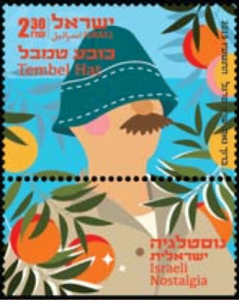 In the early days of the State of Israel nearly everyone wore Tembel hats, making it a common symbol of “the Israeli”. This is how renowned caricaturist Dush represented the mythological Sabra Srulik, along with his short khaki pants, open collared shirt and sandals. The Tembel hat was popular because it was inexpensive (it was produced from scraps of textile fabrics), it could be used to wipe sweat from the wearer’s face, folded into a triangle that fit comfortably into a pant pocket, and was easy to wash.
In the early days of the State of Israel nearly everyone wore Tembel hats, making it a common symbol of “the Israeli”. This is how renowned caricaturist Dush represented the mythological Sabra Srulik, along with his short khaki pants, open collared shirt and sandals. The Tembel hat was popular because it was inexpensive (it was produced from scraps of textile fabrics), it could be used to wipe sweat from the wearer’s face, folded into a triangle that fit comfortably into a pant pocket, and was easy to wash.
Soda Siphon
 The Soda Siphon was a metal container used to produce “homemade” soda. Water was turned into soda when gas from a small container attached to the siphon released bubbles into the device.
The Soda Siphon was a metal container used to produce “homemade” soda. Water was turned into soda when gas from a small container attached to the siphon released bubbles into the device.
The Soda Siphon was so popular in its day that it became a common wedding gift. In a wellknown skit called “Wedding Photographer”, Israeli comedian Gadi Yagil said, “… do you know that you got 100 Soda Siphons? What do you do in your spare time? Make soda?…”.
Sussita
 The Sussita car was assembled in Israel from 1960 to 1975 at the Autocars factory in Tirat Hacarmel. The body was made of fiberglass. According to a common tale, the Sussita was favored by camels in Southern Israel, because they could bite off chunks and gleefully eat them. A number of Sussita models were manufactured: a 2-door model that looked like a box and was nicknamed accordingly; a station wagon; and a Sussita pick-up truck that had a passenger-cab in the front and a load cab in the back.
The Sussita car was assembled in Israel from 1960 to 1975 at the Autocars factory in Tirat Hacarmel. The body was made of fiberglass. According to a common tale, the Sussita was favored by camels in Southern Israel, because they could bite off chunks and gleefully eat them. A number of Sussita models were manufactured: a 2-door model that looked like a box and was nicknamed accordingly; a station wagon; and a Sussita pick-up truck that had a passenger-cab in the front and a load cab in the back.
—David Sela
Chairman, Council for Promoting Israeli Heritage
Editor of the Israeli Online Nostalgia website
The themes for the stamp series were selected based on a survey of the 202,281 members of the Online Nostalgia website. Of those surveyed, 13,103 gave the most votes to the selected items. Our thanks to David Sela and the Online Nostalgia website for their assistance. 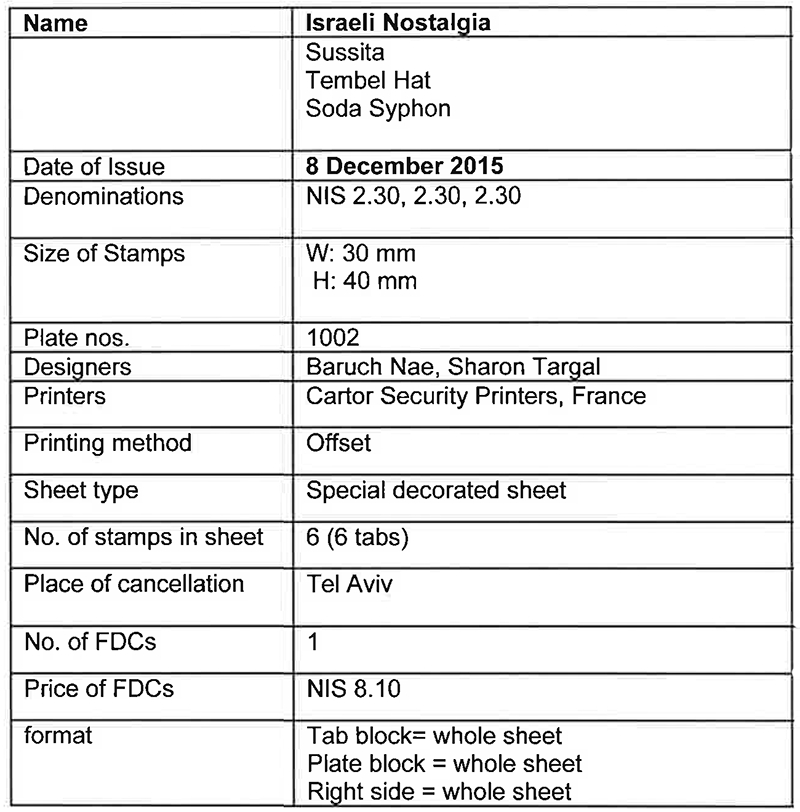
Nili Centenary (Israel 2015)
December 2015
Nili: acronym for “Netzach Israel Lo Yishaker” The Eternity of Israel will not deceive (Samuel I, 15:29)
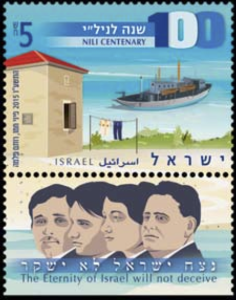 Dreamers and warriors, bearers of the rebellion against the Ottoman Empire.
Dreamers and warriors, bearers of the rebellion against the Ottoman Empire.
The underground Nili network was established in 1915 and operated in Eretz Israel during WWI. Its objectives were:
- To assist the British effort to conquer Eretz Israel by gathering information.
- To support the Jewish Yishuv in Eretz Israel in a time of famine and disease.
- To draw world attention to what was happening in Eretz Israel.
- To fulfill the dream of establishing a Jewish State in Eretz Israel.
Nili was founded and led by agronomist Aaron Aaronsohn from Zikhron Ya’akov, joined by his sister Sarah and brother Alexander, as well as Avshalom Feinberg from Hadera, brothers Na’aman and Eitan Belkind from Rishon LeZion, Yosef Lishansky from Metula and dozens of others.
The organization operated from Atlit where Aaron’s Agricultural Experiment Station was located. British forces sailed regularly between Egypt and Atlit – the British warship Managam frequently came ashore at Atlit to collect the information gathered by Nili members. Information was also passed on via homing pigeon.
In the spring of 1917 rumors about the espionage organization circulated around the Yishuv. A number of events led to the exposure of the organization in September 1917: a British coin was found in the market in Ramleh, a homing pigeon failed to complete its mission and landed in the governor’s yard in Caesarea and Na’aman Belkind was arrested by Turkish authorities.
Following these events, the Turks began a campaign of threats and terror against the Jewish Yishuv in order to apprehend Nili members. Many were in fact caught and tortured. Sarah Aaronsohn committed suicide after undergoing severe torture. Na’aman Belkind and Yosef Lishansky were executed in Damascus.
The bravery and heroism of the men and women of Nili helped the British enter Eretz Israel and end the Ottoman rule.
—Beit Aaronsohn Nili Museum
Description of the Stamp, the First Day Cover and the Cancellation
The stamp features the British warship Managam across from the Atlit shore and the house in the vineyard in Zikhron Ya’akov from which they signaled the Managam.
The stamp tab features portraits of Aaron Aaronsohn, Sarah Aaronsohn, Avshalom Feinberg and Yosef Lishansky.
The First Day Cover bears a picture of the house in the Agricultural Experiment Station from which the Managam was signaled. The signals were made by opening and closing the shutters or hanging dark or white laundry.
The cancellation features Aaron Aaronsohn’s home on Ha’Meysadim (founders) St. in Zikhron Ya’akov.
The Mamluk Postal Road – Philately Day (Israel 2015)
December 2015
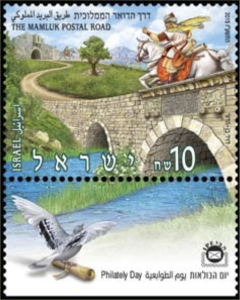 The Postal Road established by the Mamluk Empire in Eretz Israel (1260-1516) ran from the capital in Cairo to the capital of the north – Damascus and other important centers. This main route and its branches served as a means of passing news between the outlying areas of the Empire and the capital.
The Postal Road established by the Mamluk Empire in Eretz Israel (1260-1516) ran from the capital in Cairo to the capital of the north – Damascus and other important centers. This main route and its branches served as a means of passing news between the outlying areas of the Empire and the capital.
The road from Egypt, which passed through the northern Sinai Desert, forked into two branches in Gaza – one toward Karak in Jordan via Beit Guvrin and Hebron and the other toward Damascus via Jitin (Ge’a), Qatra (Gedera), Ludd, Jinin, Baysan (Beit She’an), etc.
The Mamluk postal network was based on three components: equestrian post, homing pigeons and fire/smoke signals. This system was called Barid. The land Barid utilized fast horses whose sole purpose was to transport messages from the Sultan in Cairo. The messengers who rode these horses were selected from among those closest to the ruler.
The fourth Mamluk Sultan, al-Zahir Baybars al- Bunduqdari (1260-1277), who established the Mamluk Empire, reintroduced the Barid and incorporated it into his military structure. The peak of the Barid was during the third reign of al-Nasir Muhammad ibn Qalawun (1310-1341).
This postal system was based on stations positioned at regular intervals along the route where messengers were able to obtain fresh horses. Approaching messengers were recognized by station personnel based on identifying marks such as a yellow silk scarf tied to the messenger’s neck, a large silver medallion hanging from the messenger’s neck or a horse with a tied tail – and were met with a fresh horse so they could continue immediately on their journey.
It took no more than four days for the post to reach Damascus from Cairo.
In order to minimize the obstacles en route, Baybars built and repaired bridges. This Sultan’s hallmark – the lion/cheetah – appears on many of his buildings (and also on the stamp) and it decorated at least two of the bridges that he built: one near Cario and the other the Gandas Bridge near Lod which was one of the main stations along the Barid.
The Mamluk Postal Road left its impression on Eretz Israel and a number of impressive ruins from that network attest to its importance as a key land bridge among various countries.
—Dr. Katia Cytryn-Silverman
Lecturer at the Institute of Archaeology and the Department of Islamic and Middle Eastern Studies, The Hebrew University of Jerusalem
WSS-NY 2016 Hotel Rooms Hot Sellers
November 7, 2015
For Immediate Release
WSS-NY 2016 Hotel Rooms Hot Sellers
After just a few weeks of availability, three hotel properties are nearly sold out of rooms reserved for visitors to World Stamp Show-NY 2016, taking place May 28-June 3 at the Javits Center in New York City.
Weekly hotel room updates continue to be sent to the show’s Executive Committee by Experient, the hotel consolidator. A total of 27 properties in New York City and nearby New Jersey were selected offering discounts to show-goers covering roughly 15,000 room nights over the show’s 8 day run.
Wade Saadi, WSS-NY 2016’s President, explained further.
“Hearing that three hotels already are booked 89%, 93% and 94% more than six months before the show opens sends a strong signal that we have a lot of collectors and their families anxious for our doors to open and take advantage of the great deals. Room reservations will only accelerate in the next month as hundreds of exhibitors around the world learn that their entries have been accepted to take part in the competition.”
Experient additionally expressed their pleasure in the brisk reservation rate for the other hotels and encourages anyone planning to attend to make their selection as soon as possible to avoid disappointment.
A link to the reservations page can be found on the World Stamp Show-NY 2016 home page at http://www.ny2016.org. A credit card guarantee is all that is needed to hold a room, with payment not due until arrival in May or June.
Thomas M. Fortunato
Rochester, NY
Chairman, Marketing and Public Relations
World Stamp Show- NY 2016
http://www.ny2016.org
Join us May 28-June 4, 2016
Javits Center, New York City





